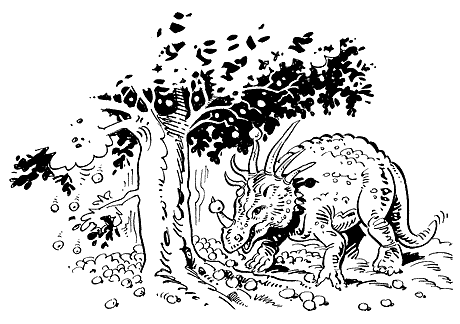sauro-, saur-, -saurus, -saurid, -saur,
-sauria, -saurian +
(Greek: lizard, reptile, serpent; used especially with reference to "dinosaurs")
Fabrosaurus
Means “Fabre’s lizard” (true reversed vertebrae lizard) from Early Jurassic South Africa. Named for Jean Henri Fabriel, a French geologist, and a colleague of Ginsburg’s (the nomenclator, 1964) on the expedition that collected the fossil in Basutoland, South Africa. Named by Leonard Ginsburg in 1964.
Fenestrosaurus
This nomenclature ("window lizard") is no longer recognized by scientists because they found that it described an animal that was previously given another name which is Oviraptor. Named by Henry Fairfield Osborn in 1924.
Frenguellisaurus
A “Frenguelli lizard” from Late Triassic Argentina. Named in honor of Dr. Joaquin Frenguelli (1883-1958), an Italian-born paleontologist who worked in Argentina and who did important paleontological and geological work in the Triassic basin of the Ischigualasto-Villa Union. This fossil is also referred to as Herrerasaurus. Named by Argentinian paleontologist Fernando E. Novas in 1986.
Fresnosaurus
A “Fresno lizard” from Late Cretaceous North America. It was named for Fresno County, California where the fragmentary-type skeleton was found in the Moreno Formation. Named by U. S. paleontologist Samuel Paul Welles in 1943.
Futabasaurus
A “Futaba [Grouip] lizard” from Late Cretaceous Japan. Named by Canadian paleontologist Lawrence Lambert in 1990.
Gadolosaurus
A small Russian Iguanodontid that is not yet officially described. Named by Japanese paleotologist Tsunemasa Saito in 1979.
Gargoyleosaurus
A “gargoyle lizard” from Late Jurassic Wyoming. It was named for a sculptured gutter in the form of a grotesque monster, used to decorate Gothic churches (from French gargouille). It was named for the resemblance of the skull to the head of a gargoyle in profile. Named by Kenneth Carpenter (Denver Museum of Natural History), Gregory A. Miles, and Cloward in 1998.
Gasosaurus
A “gas [company] lizard” from Middle Jurassic China. It was named for the natural gas company employees who discovered it in Sichuan, central China. Named by paleontologists Zhiming Dong and Tang Zhilu in 1985.

Crazier things could have happened in those days.

Gasparinisaura
The “Gasparini’s lizard” is from Middle Jurassic Argentina. It was named in honor of Dr. Zulma B. Gasparini, Argentine paleontologist, “for her contribution to the study of Mesozoic reptiles from Patagonia.” Named by Argentinian paleontologists Rodolfo Coria and Leonardo Salgado in 1996.
Genusaurus
A “knee lizard” from Early Cretaceous France. Named by Accarie, Beaudoin, Jean Dejax, Fries, Michard, and Philippe Taquet in 1995.
Georgiasaurus
A “Georgy’s lizard” from Late Cretaceous Eastern Europe. It was named to honor V. A. Ochev’s late father, Georgy Ochev; a replacement for preoccupied Georgia Ochev. This generic name, Georgiasaurus, has no connection with the country in southwest Asia named Georgia (in English), Gruziya, in Russian. Named by Ochev in 1977.
Geranosaurus
A “crane lizard” from Early Jurassic South Africa’s Cape Province. Named by Scottish physician Robert Broom in 1911.
Giganotosaurus
A "giant-southern lizard" from Late Cretaceous Patagonia, Argentina. Named in 1995 by Argentinian paleontologists Rodolfo Coria and Leonardo Salgado.
Gigantosaurus
This nomenclature ("giant lizard") is no longer recognized by scientists because they found that it described an animal that was previously given another name which is Pelorosaurus. Named by Harry Govier Seeley in 1869.
Gilmoreosaurus
This nomenclature (“Gilmore’s lizard”) is no longer recognized by scientists because they found that it described an animal that was previously given another name which is Mandschurosaurus. Named by Brett-Surman in 1979.


